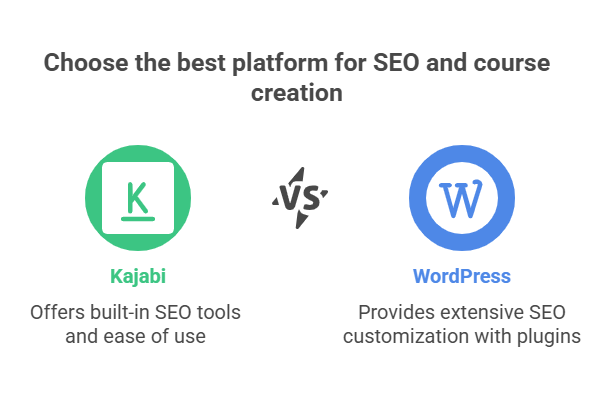Kajabi SEO: Proven Strategies to Skyrocket Your Course Visibility in 2025
Key Takeaways
- Kajabi provides essential SEO tools that are sufficient for most creators who want to optimize their sites for better visibility.
- Advanced customization options may be limited compared to platforms like WordPress, but Kajabi is perfect for those who value simplicity.
- To succeed in SEO, focus on keyword research, creating quality content, mobile optimization, and building backlinks.
- Kajabi’s user-friendly interface and mobile optimization make it a great choice for creators who want to build and market their online courses with ease.

SEO Challenges and Opportunities for Kajabi Users
If you’re trying to get your online course noticed these days, you know how tough it can be—especially with so many people now using Kajabi. Just having a great course isn’t enough anymore.
To find your ideal students, you have to get your stuff to show up in their search results, and that means SEO.
Don’t sweat it, though! Kajabi has some cool built-in SEO tools that can help you tweak things so your course climbs higher in results and earns more visitors without you having to pay for ads.
This article shows you how Kajabi’s SEO features work and gives you tips for using them so more people can find your site.
When you make the most of Kajabi’s tools, your search engine ranking can improve, your site can get more visitors, and your course business can really take off.
Does Kajabi Have SEO?
Yes, Kajabi offers essential SEO features that can enhance your site’s search engine performance.
Kajabi provides built-in SEO tools for course creators, membership site owners, and digital product sellers. Here are some of the key SEO features that Kajabi offers:
- Customizable Meta Tags: You can edit the title tags, meta descriptions, and URLs for each page, improving your site’s chances of ranking well on search engines.
- Mobile Optimization: Kajabi’s templates are responsive, meaning they automatically adjust to look great on any device. Search engines prioritize mobile-friendly websites.
- Blogging Capabilities: The platform allows creators to publish regular blog posts, which can be indexed by search engines and help drive traffic.
- Clean URL Structure: Kajabi allows you to create SEO-friendly URLs that are easy for search engines to understand.
Although Kajabi’s SEO tools are sufficient for most users, those seeking advanced customization may need additional integrations or third-party tools.
Kajabi SEO Statistics (2025)
Understanding current trends can guide your SEO strategy. Here are some recent statistics that highlight the growing impact of SEO on Kajabi users:
- Creator Earnings: In 2024, Kajabi creators earned over $2 billion, with projections set to reach $9 billion by 2025, demonstrating the increasing potential for success when SEO is utilized effectively (source).
- Mobile Traffic: Approximately 60% of Kajabi traffic comes from mobile users, which highlights the importance of mobile optimization, a key SEO ranking factor (source).
- Global User Demographics: Kajabi’s user base spans globally, with the U.S. leading at 58.82%, followed by India and the UK (source).
- AI Tools: Kajabi’s introduction of the AI Creator Hub has drastically reduced content creation time by up to 90%, allowing creators to focus more on content that can attract organic search traffic (source).

Kajabi vs. WordPress: SEO Comparison
When considering SEO, it’s important to evaluate Kajabi against other platforms. WordPress, for instance, is another popular choice for course creators.
| Feature | Kajabi | WordPress |
|---|---|---|
| SEO Customization | Moderate | Extensive |
| Built-in SEO Tools | Yes, basic | Yes, with plugins like Yoast SEO |
| Ease of Use | High | Moderate (requires plugins) |
| Cost | Subscription-based | Free (with optional paid plugins) |
While Kajabi offers easy-to-use SEO features, WordPress provides more granular control through plugins like Yoast SEO. WordPress is the better choice if you need extensive customization. For many creators who prefer simplicity, Kajabi’s built-in features are sufficient for good SEO performance.
How to Achieve SEO Success on Kajabi
Achieving high rankings on search engines doesn’t happen overnight. By focusing on these core SEO strategies, you can boost your Kajabi site’s visibility:
1. Keyword Research
- Use tools like Google Keyword Planner, SEMrush, or Ahrefs to identify keywords that are relevant to your courses.
- Incorporate these keywords naturally into page titles, meta descriptions, and URLs.
2. High-Quality Content
- Focus on creating content that is informative, engaging, and relevant to your audience. Quality content helps you rank higher on search engines.
3. Mobile Optimization
- Kajabi’s templates are responsive, but ensure that your site is fully optimized for mobile devices. Google prioritizes mobile-friendly websites.
4. Backlink Building
- Acquire backlinks from authoritative sites in your niche. High-quality backlinks signal to search engines that your site is trustworthy.
5. Site Speed
- Optimize your website’s loading speed using tools like Google PageSpeed Insights. Faster websites improve user experience and search rankings.
6. Internal Linking
- Create a clear site structure by linking related content. This not only enhances the user experience but also helps search engines index your pages more efficiently.
7. Technical SEO
- Ensure that your site has proper header tags, schema markup, and an easy-to-follow site structure.
By focusing on these strategies, you can improve your site’s SEO and increase organic traffic to your Kajabi site.
What Is Kajabi Used For?
Kajabi is primarily used by creators, educators, and entrepreneurs to build and market their online courses, memberships, and digital products. Here’s how you can use Kajabi:
- Course Creation: Kajabi provides tools to create and deliver online courses in a variety of formats, from video lessons to quizzes.
- Membership Sites: You can build a membership site to offer exclusive content to paying subscribers.
- Email Marketing: Kajabi includes built-in email marketing features to help you stay connected with your audience and drive conversions.
- Sales Funnels: Kajabi helps you create landing pages, sales pages, and checkout pages to convert visitors into paying customers.
- Digital Products: You can sell digital products like eBooks, templates, and more directly from your site.
With all these tools in one platform, Kajabi is ideal for those looking to streamline their online course creation and marketing efforts.
Is Kajabi Good for SEO?
Yes, Kajabi is a solid choice for SEO, particularly for course creators who want a straightforward, user-friendly platform. Kajabi’s built-in SEO features include customizable meta tags, mobile optimization, and clean URL structures. These tools can help you achieve higher search engine rankings without the need for advanced technical SEO skills.
While Kajabi may not offer the same level of customization as WordPress, it is a good option for creators who want a simple yet effective platform to build and market their digital products.
Grasping SEO and Why It Matters for Your Online Courses
SEO, short for Search Engine Optimization, is basically how you make sure people can easily find you online. If you create courses, this means tweaking things so that anyone searching for what you teach can spot your stuff on Google right away.
Today, getting the hang of SEO is a must. There are tons of courses out there, and learners don’t have time to sift through all of them, so they choose the first few that look right. A solid SEO game means you have a better shot at being one of those first results they click on.
By choosing the right keywords and weaving them into your site, you make what you say match what people are actually typing into search bars. When that happens, more folks land on your Kajabi site, and more of them sign up for your course.
Plus, good SEO makes you look legit. When people see your course sitting at the top of the search results, they’re more likely to think, “This must be good—let’s check it out.” So, getting SEO right not only gets you noticed; it also makes your course feel more valuable to anyone thinking about enrolling.
The Basics of Kajabi SEO
The basics of Kajabi SEO mean making your course site friendlier to Google so people can find your stuff online.
First up, look at how your site is laid out. Make menus easy to find and pages to click through. A tidy, simple site helps real visitors and makes Google’s robots happy when they come to check out your pages.
After the layout, pay attention to title tags, meta descriptions, and header tags. Each of these little bits tells Google what your posts and videos are about, so don’t skip them.
When you add images, give them clear filenames and use alt text. This makes your site nicer for people using screen readers and helps Google’s bots understand what the pictures show, boosting your ranking a bit.
Finally, your Kajabi site needs to look good on phones. More people are learning on the go, and if your site shrinks and rearranges to fit their screen, they’ll stay longer—and so will Google.
Keyword Research for Course Titles and Descriptions
Keyword research is the bedrock for solid Kajabi SEO. It shows you exactly what future students are typing in Google when they want courses like the one you’re creating.
Start by jotting down themes tied to your course. Focus on the actual content but also zero in on the headaches your audience is desperate to fix.
Then fire up Google Keyword Planner or Ubersuggest. These tools will spit out the most searched terms and phrases that fit your tiny corner of the internet.
Drop these keywords naturally into your course titles and descriptions. Keep it straightforward and still think SEO—find that sweet spot so human readers and search engines are both happy.
Remember to scoop up long-tail keywords. They’re usually less crowded and bring in the right people. Picture how someone might type a detailed question looking for your know-how, then fold those phrases into snappy text that totally clicks with what they’re after.
Optimizing Your Course Website and Landing Pages
Your course website is your digital storefront. It must attract attention and convert visitors into students. Start by ensuring your site loads quickly; slow pages can turn potential customers away.
Next, focus on an intuitive layout. Users should navigate seamlessly from one section to another without confusion. Use clear calls-to-action (CTAs) that guide them toward enrolling in your courses.
Don’t forget the power of visuals. Engaging images and videos enhance user experience but optimize their sizes to maintain fast loading times.
Incorporate testimonials and reviews prominently on your landing pages. Social proof builds trust, encouraging visitors to take a leap of faith and sign up for your offerings.
Ensure mobile optimization is a priority as more users browse through smartphones or tablets nowadays. A responsive design keeps all elements functional across devices, ultimately increasing conversions significantly.
Leveraging Social Media for Kajabi SEO
Social media is a powerful tool for enhancing your Kajabi SEO efforts. By sharing valuable content related to your courses, you can drive traffic back to your site and improve visibility.
Start by identifying the platforms where your target audience spends their time. Create engaging posts that highlight course benefits, testimonials, and sneak peeks of content. This not only builds interest but also encourages shares.
Utilize relevant hashtags to expand reach beyond your immediate followers. Join groups or forums related to your niche; contribute meaningful insights while subtly promoting your courses when appropriate.
Don’t forget about social proof—encourage students to share their experiences online. User-generated content can enhance credibility and attract new learners organically through word-of-mouth referrals.
Monitor engagement metrics closely. Adjust strategies based on what resonates most with your audience for maximum impact on search rankings over time.
Utilizing Audio and Video Content for Higher Rankings
Integrating audio and video content into your Kajabi courses can significantly boost your SEO efforts. Search engines love diverse media formats, which can enhance user engagement and dwell time on your site.
Consider creating high-quality videos that explain key course concepts or introduce modules. These not only make learning more interactive but also improve the chances of appearing in search results for relevant queries.
Podcasts are another avenue to explore. They allow you to delve deep into topics while showcasing your expertise, attracting an audience that prefers auditory learning experiences.
Don’t forget to optimize these files with descriptive titles, tags, and transcripts. This makes it easier for search engines to index them appropriately and increases accessibility for all users.
Utilizing rich media effectively positions your course as a valuable resource, enhancing visibility across various platforms while capturing the attention of potential students searching online.
Staying Up-to-Date with Google Algorithm Changes
Google’s algorithm is constantly evolving. Staying informed about these changes can significantly impact your Kajabi SEO efforts.
Regularly check resources like Google’s Webmaster Central Blog or Search Engine Journal. These platforms offer insights into updates and best practices directly from the source.
Join online communities focused on digital marketing and search engine optimization. Engaging with peers can provide valuable perspectives on recent shifts that may affect your ranking.
Consider subscribing to newsletters from SEO experts who analyze trends and their implications for content creators.
Monitoring industry leaders on social media also keeps you in the loop regarding discussions around algorithm updates, new features, and essential tips.
Always test how any change affects your course visibility. Adjusting your strategy based on real-time feedback ensures you’re not left behind in the fast-paced world of SEO.
Case Studies: Successful Kajabi Users and their SEO Strategies
Many successful Kajabi users have implemented smart SEO strategies that propelled their courses to new heights. One standout is a fitness coach who revamped her course titles with targeted keywords. By focusing on specific niches, she attracted the right audience and saw enrollment soar.
Another example is an online marketing expert who optimized landing pages with compelling CTAs and rich content. This not only improved search rankings but also boosted conversion rates significantly.
A graphic designer utilized video content effectively by creating engaging tutorials hosted directly on his Kajabi site. His videos ranked high in search results, driving organic traffic and enhancing user engagement.
These case studies highlight that continuous optimization can lead to remarkable success in Kajabi SEO. Adapting tactics based on analytics helps users stay ahead in an ever-evolving digital landscape.
Common Mistakes to Avoid
When it comes to Kajabi SEO, avoiding common pitfalls can make a significant difference in your course’s visibility. Many creators overlook the importance of optimizing every element of their courses. Failing to conduct thorough keyword research is one major mistake; without the right keywords, even the best content may go unnoticed.
Another frequent oversight involves neglecting mobile optimization. With an increasing number of users accessing online courses via smartphones and tablets, having a responsive design is crucial for both user experience and search rankings.
Many course creators also forget about internal linking within their Kajabi site. Linking related courses or blog posts not only keeps visitors engaged but also helps search engines understand your site’s structure better.
Duplicate content can be detrimental too. Always strive for original descriptions and titles that reflect your unique approach—this will help you stand out in a crowded market.
Don’t underestimate the power of analytics. Ignoring data means missing opportunities for improvement and refinement over time. Regularly check performance metrics to identify what’s working and what needs adjustment.
By steering clear of these missteps, you’ll set yourself up for greater success with Kajabi SEO strategies tailored specifically for your audience’s needs in 2025 and beyond.

Conclusion
Kajabi is still one of the best options for creators who want to make and sell their digital products, memberships, and online courses. The SEO tools on the platform are simple compared to some other options, but they have everything most creators need to start and grow their online businesses. You can get more organic traffic to your Kajabi site by doing things like optimising your keywords, making your site mobile-friendly, and writing high-quality content.
Frequently Asked Questions (FAQs)
Is Kajabi good for SEO?
Yes, Kajabi provides sufficient SEO tools for most creators, although more advanced SEO features may require third-party integrations.
What is Kajabi used for?
Kajabi is an all-in-one platform for creating, marketing, and selling online courses, memberships, and digital products.
How to achieve SEO success on Kajabi?
Focus on keyword research, quality content, mobile optimization, and building backlinks. Make sure your site loads quickly and has a clear structure.
Which CMS/LLM platform is best for SEO?
WordPress provides more advanced SEO customization through plugins like Yoast SEO. Kajabi is a good choice if you want ease of use, but WordPress is better for those needing advanced features.
Does Kajabi have SEO?
Yes, Kajabi offers built-in SEO features that allow you to optimize your site for search engines, including customizable meta tags and mobile optimization.




Raptor Vision
August 7, 2025Great insights and valueable information